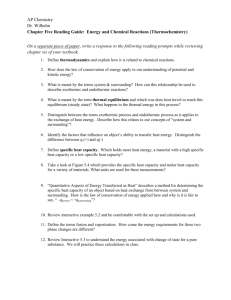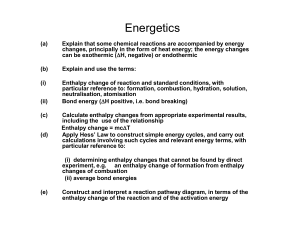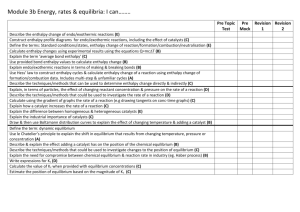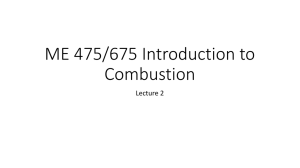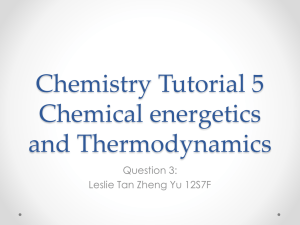Text Questions
advertisement
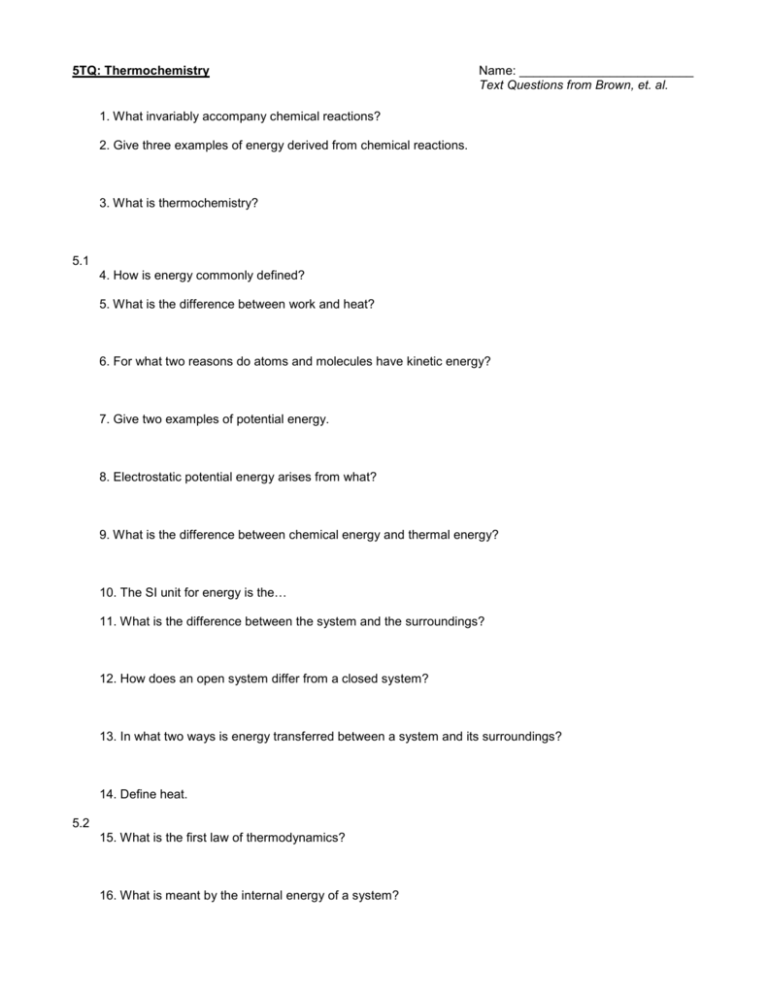
5TQ: Thermochemistry Name: _________________________ Text Questions from Brown, et. al. 1. What invariably accompany chemical reactions? 2. Give three examples of energy derived from chemical reactions. 3. What is thermochemistry? 5.1 4. How is energy commonly defined? 5. What is the difference between work and heat? 6. For what two reasons do atoms and molecules have kinetic energy? 7. Give two examples of potential energy. 8. Electrostatic potential energy arises from what? 9. What is the difference between chemical energy and thermal energy? 10. The SI unit for energy is the… 11. What is the difference between the system and the surroundings? 12. How does an open system differ from a closed system? 13. In what two ways is energy transferred between a system and its surroundings? 14. Define heat. 5.2 15. What is the first law of thermodynamics? 16. What is meant by the internal energy of a system? 17. A. We generally do NOT know what about a system? B. However, when the system changes, we can often find out WHAT? 18. What do we need in order to apply the first law of thermodynamics? 19. When Efinal > Einitial, E has a ___ value; when Efinal < Einitial, E has a ___ value. 20. In a reaction, the initial state refers to the ________ and the final state refers to the _________. 21. Write the equation for the first law of thermodynamics and define the terms. 22. What are the sign conventions for E, q, and w? (See Table 5.1.) 23. What is the difference between an endothermic and an exothermic process? 24. Why is the total internal energy of a system proportional to the amount of matter in the system? 25. A. The value of a state function depends ONLY on… B. It DOESN’T depend on… 26. A change in a system’s internal energy depends only on the initial and final _______ of the system, regardless of the breakdown of the energy change in terms of ______ and ______. 5.3 27. When a change is open to the atmosphere, the work usually produced is associated with what? 28. What is pressure-volume (P-V) work? 29. __________ accounts for heat flow in processes occurring at _________ _________ when no forms of work except _____ work are done. 30. At constant pressure, the change in enthalpy equals… 31. For what two reasons is enthalpy a more useful function than internal energy? 32. Why are “change in enthalpy” and “change in internal energy” about the same for most reactions? 33. What has happened when H is positive? …when H is negative? 5.4 34. A. The equation for calculating enthalpy change is ___________________. B. Enthalpy change could also be called… …or… C. The enthalpy change is sometimes written as… 35. When H is reported at the end of a balanced equation without explicitly mentioning the amounts of substances involved, the coefficients are understood to represent… 36. A. Enthalpy is an ___________ property, meaning that if the combustion of 1 mol of a substance releases 400 kJ of heat, then the combustion of 2 mol will release ________ of heat. B. How do the enthalpy changes for a reaction and its reverse reaction compare? C. The enthalpy change for a reaction depends on the _______ of the reactants and products. 37. What are the two ways in which H can be determined? 5.5 38. Often, how do we determine the magnitude of heat flow? 39. For a given quantity of heat, what varies from substance to substance? 40. What is heat capacity? 41. What is the difference between molar heat capacity and specific heat? 42. How does the high specific heat of water affect Earth’s climate? 43. For a coffee-cup calorimeter, why doesn’t the pressure change? 44. The heat gained by the solution equals that released by the reaction, assuming what? 45. The heat gained by the solution is ______ ___ ____________ but ___________ ___ _____ to the heat released by the reaction. In equation form, we would write this: _______________. 46. What is the approximate specific heat of very dilute solutions? 47. What usually happens in a combustion reaction? 48. With a bomb calorimeter, when is the water temperature measured? 49. Reactions in a bomb calorimeter are carried out under ______________________ conditions. 5.6 50. The H for a reaction can be calculated from ____________ H values of _______ ___________. 51. What does Hess’s law state? 52. Hess’s law provides a means of calculating energy changes that are… 5.7 53. By “standard conditions,” we usually mean a pressure of ______ and a temperature of _____. 54. How do we define standard enthalpy change? 55. The superscript o indicates… 56. Hof of a compound is the change in enthalpy for… 57. Why is the Hof of the most stable form of any element zero? 58. Write the equation for the standard enthalpy change of a reaction, and tell what m and n are. 5.8 59. What is fuel value? 60. _______________ known as starches are broken down by the body into glucose, which is sometimes referred to as _______ _______. It reacts with ____ to produce _____ and _____ and provides a fuel value of ________, or ________. 61. The average fuel value of fats is ________, or _______, and they are well suited to serve as the body’s energy reserve for the following two reasons: 62. Proteins provide a fuel value of _______, or _______. 63. The greater the percentage of ________ and __________ in a fuel, the higher its fuel value. 64. Natural gas consists of _________ ______________. 65. List five renewable energy sources.


